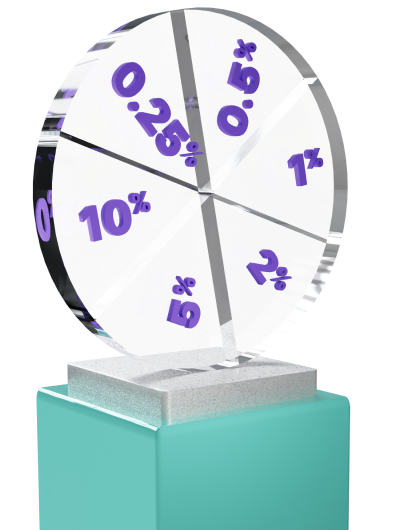All trading involves risk. It is possible to lose all your capital.
Leverage affects the funds required to place a position, multiplying your buying power and allowing you to open a position larger than your deposit. Using leverage means that you can trade amounts larger than the amount of money in your trading account.
The leverage amount is expressed as a ratio, for instance 1:100, 1:500, 1:1000 etc.
Assuming that you have $1,000 in your trading account and you trade ticket sizes of 500,000 USD/JPY, your leverage will equate 1:500.


Similar to leverage, the margin requirement set by the broker affects the funds required to place a position and is expressed as a percentage (%) of the “full position size”, also known as the “notional value” of the position you wish to open.
Depending on the trading asset, the amount of margin required to open a position varies, such as 0.25%, 0.5%, 1%, 2%, 5%, 10% or higher.
This percentage (%) is known as the margin requirement.
Required margin is the amount of money (collateral) required to open a position with your broker, after applying leverage or margin Requirement (margin rates).
For instance, on a 1% margin requirement (or leverage 1:100), a position of $1,000,000 will require a deposit of $10,000.

As part of its ongoing risk management policy, TigerFX developed an advanced Floating Leverage tool designed to protect the parties involved in a transaction by reducing the trading exposure and balancing risk. To achieve this, the Floating Leverage tool automatically adapts to the client’s trading positions, progressively reducing the leverage as the volume on a single instrument increases.
The following leverage structure applies to forex trading and it’s indicative for the USDJPY pair:
| Tiers | Open Lots | Maximum Leverage |
|---|---|---|
| Tier 1 | 0-50 | Max 1:500* |
| Tier 2 | >50-75 | Max 1:200* |
| Tier 3 | >75-100 | Max 1:100* |
| Tier 4 | >100-150 | >Max 1:50* |
| Tier 5 | >150+ | Max 1:10* |
*or account leverage, whichever is less
If a client has positions open across multiple forex currency pairs, the leverage will be calculated separately on each forex currency pair. Consider the below cases:
1. A trader has 150 lots Buy on USDJPY, and then starts trading EURUSD. The margin requirement for EURUSD will not be affected by the existing USDJPY positions.
2. A trader has 150 lots long position on USDJPY and 200 lots short on the same pair. For margin calculation, the side with the largest volume will be used, i.e the 200 lots short position.
3. A trader with three positions of 40 lots long (or short) – i.e. in total 120 lots long (or short), and a trader of a single position of 120 lots long (or short), would require the same margin provided their accounts have identical leverage settings.
If the account leverage is less than the leverage levels provided in the table, then the account leverage will be considered in the margin calculation instead.
Client Account in USD
with 1:100 Leverage
Assume that the USD account has 100 lots long position on USDJPY.
In this example, the account leverage is less than or equal to all relevant values in the Floating Leverage table, so the margin required will not be affected.
| Open Volume (in Lots) | Maximum Leverage | Applied Leverage | Margin |
|---|---|---|---|
| 0-50 | 1:500 | 1:100 | 50 (lots) * 100,000 100 (leverage) = 50,000 USD (margin) |
| >50-75 | 1:200 | 1:100 | 25 (lots) * 100,000 100 (leverage) = 25,000 USD (margin) |
| >75-100 | 1:100 | 1:100 | 25 (lots) * 100,000 100 (leverage) = 25,000 USD (margin) |
Total Required Margin: 100,000 USD
Account in USD with 1:500 Leverage
Assume that the USD account has 125 lots (i.e. 125 x 100,000 USD = 12,500,00 Volume in USD) long position USDJPY.
In this example, the account leverage is more than or equal to values in the Floating Leverage table, so the margin required would be calculated as follows:
| Open Volume (in Lots) | Maximum Leverage | Applied Leverage | Margin |
|---|---|---|---|
| 0-50 | 1:500 | 1:500 | 50 (lots) * 100,000 500 (leverage) = 10,000 USD (margin) |
| >50-75 | 1:200 | 1:200 | 25 (lots) * 100,000 200 (leverage) = 12,500 USD (margin) |
| >75-100 | 1:100 | 1:100 | 25 (lots) * 100,000 100 (leverage) = 25,000 USD (margin) |
| >100-125 | 1:50 | 1:50 | 25 (lots) * 100,000 50 (leverage) = 50,000 USD (margin) |
Total Required Margin: 97,500 USD
Account in USD with 1:500 Leverage
Now assume that the same account opens a position of 100 Lots EURUSD long (or short), whereas the EURUSD rate is at 1.32500.
In this example, the account leverage is more than or equal to values in the indicative Floating Leverage table, so the margin required would be calculated as follows:
| Open Volume (in Lots) | Maximum Leverage | Applied Leverage | Margin |
|---|---|---|---|
| 0-50 | 1:500 | 1:500 | 50 (lots) * 100,000 500 (leverage) = 10,000 EUR (margin) |
| >50-75 | 1:200 | 1:200 | 25 (lots) * 100,000 200 (leverage) = 12,500 EUR (margin) |
| >75-100 | 1:100 | 1:100 | 25 (lots) * 100,000 100 (leverage) = 25,000 EUR (margin) |
| >100-125 | 1:50 | 1:50 | 25 (lots) * 100,000 50 (leverage) = 50,000 EUR (margin) |
Total Required Margin: 97,500 EUR * 1.32500 = 129,187.5 USD
So the trader would require 97,500 USD margin for USDJPY and 129,187.5 USD margin for EURUSD, thus giving a total margin of 226,687.5 USD for both positions.
Similar to forex trading, the Floating Leverage tool will apply when trading instruments that have a Margin (%) Requirement, such as Precious Metals and Stocks. It progressively increases the Margin Requirement % (which essentially reduces the leverage value as we’ve seen on the Forex examples above) as the volume (in lots) on a single instrument increases.
The following indicative tables illustrate the different Margin Requirement structures across Metals and Stocks:
| Open Volume (in Lots) | Margin Requirement |
|---|---|
| 0-15 | 1% |
| >15-30 | 2% |
| >30-45 | 4% |
| >45-60 | 6% |
| >60+ | 10% |
This is once again done per Trading Instrument, so if a client has open positions across multiple Instruments, the leverage will be calculated separately on each symbol. For example, if a trader has a position in Silver and then starts trading Gold, the margin requirement increase for Gold will not be affected by the existing Silver positions.
Assume we have a USD account with 15 lots Buy (or Sell) of Gold at spot price of 1,600 USD.
| Open Volume (in Lots) | Margin Requirement | Margin |
|---|---|---|
| 0-15 | 1% | 15(lots) *100(oz) *1600(price of gold spot) * 1%(margin req.) = 24,000 USD |
Total Required Margin: 24,000 USD
| Open Volume (in Lots) | Margin Requirement | Margin |
|---|---|---|
| 0-15 | 1% | 15(lots) *100(oz) *1600(price of gold spot) * 1%(margin req.) = 24,000 USD |
| >15-30 | 2% | 15(lots) *100(oz) *1600(price of gold spot) * 2%(margin req.) = 48,000 USD |
| >30-45 | 4% | 15(lots) *100(oz) *1600(price of gold spot) * 4%(margin req.) = 96,000 USD |
| >45-60 | 6% | 15(lots) *100(oz) *1600(price of gold spot) * 6%(margin req.) = 144,000 USD |
Total Required Margin = 312,000 USD
| Open Lots (number of stocks) | Margin Requirement |
|---|---|
| 0-2000 | 10% |
| >2000-4000 | 20% |
| >4000-6000 | 40% |
| >6000-8000 | 60% |
| 8000+ | 80% |
Assume we have a USD account with 1,000 lots Buy (or Sell) of Alcoa Inc. at spot price of 10 USD.
| Open Lots (number of stocks) | Margin Requirement | Margin |
|---|---|---|
| 1000 | 10% | 1000(lots) * 10(price of of Alcoa Inc) * 10%(margin req.) = 1,000 USD |
Total Required Margin = 1,000 USD
| Open Lots (number of stocks) | Margin Requirement | Margin |
|---|---|---|
| 0-2000 | 10% | 2000(lots) *10 (price of of Alcoa Inc) * 10%(margin req.) = 2,000USD |
| >2000-4000 | 20% | 2000(lots) *10 (price of of Alcoa Inc) * 20%(margin req.) = 4,000USD |
| >4000-6000 | 40% | 2000(lots) *10 (price of Alcoa Inc) * 40%(margin req.) = 8,000 USD |
| >6000-8000 | 60% | 2000(lots) *10 (price of Alcoa Inc) * 60%(margin req.) = 12,000 USD |
Total Required Margin = 26,000 USD
All trading involves risk. It is possible to lose all your capital.
TigerFX Limited is a company registered in Marshall Island with registration number 121802 and registered address of Ajeltake Road, Ajeltake Island, MH 96960 Majuro, Marshall Islands.
Risk Warning: Our products are traded on margin and carry a high level of risk and it is possible to lose all your capital. These products may not be suitable for everyone, you should ensure that you understand the risks involved.
TigerFX does not offer its services to residents of certain jurisdictions such as USA, Iran, Cuba, Sudan, Syria and North Korea.